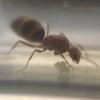I am reporting an observation between an incipient colony of Brachymyrmex cf. patagonicus of about 15-20 workers, and a small colony of Pheidole cf. floridana of about 50 workers.
I introduced the Pheidole colony to a new foraging area. These are small ants, about 1.5 mm in length. The ants have been collecting food and tailoring the entrance to their nest, which is a 16 mm test tube.
About 12 hours after introducing the Pheidole, I connected the Brachymyrmex colony to the same foraging area. The Brachymyrmex are housed in a 13 mm test tube with a polyethylene cap, which has a 1.5 mm hole in the cap to serve as an entrance. The Brachymyrmex workers have had this cap and hole for a long time, so they understand where the entrance is. Within 2-3 minutes of introduction, I observed a single Pheidole worker discover and proceed to investigate the nest entrance hole for the Brachymyrmex colony. This worker never encountered a single ant. Immediately upon sticking its head into the nest, the Pheidole worker exited and ran excitedly back to its own nest.
Upon returning to its own nest, the Pheidole worker recruited several nestmates who traveled back to the Brachymyrmex nest and began entering and exploring the nest. At this time, the Brachymyrmex workers discovered the invading Pheidole workers, and sprayed them with acid, to which the nearly equally-sized Pheidole workers immediately succumbed, some limping, unable to navigate, and subsequently collapsing if sprayed multiple times.
After this initial encounter, I thought the Brachymyrmex workers could handle themselves. But within the next few minutes, the Pheidole workers continued swarming the Brachymyrmex entrance in groups of 5 or 6, only occasionally entering the nest. Within some minutes, the panicking Brachymyrmex workers began evacuating the nest, with the queen among the first to leave, abandoning her own workers! One or two workers carried brood out of the nest. I observed some Pheidole workers grapple with Brachymyrmex workers, upon which the Brachymyrmex workers immediately stopped moving, leaving the Pheidole workers to haul the adult workers and brood back to their own nest, presumably as food.
I found this interaction interesting because the first Pheidole worker appeared to smell the Brachymyrmex presence even without contacting a single ant, in so much as I could observe. I also found it interesting that the Pheidole workers, which are relatively similarly sized, would carry the adult Brachymyrmex workers back to their own nest as food. Many ants which invade and kill other ants simply leave the dead bodies.
Several weeks ago, I placed the Brachymyrmex nest inside the foraging area of a Camponotus colony, but removed it after some weeks upon repeatedly observing a Camponotus worker stand guard at the Brachymyrmex nest entrance facing the entrance hole, as if to say "I dare you to come out!" It is fascinating that as omnipresent as this tramp ant is, incipient colonies of Brachymyrmex, at the very least, appear to be highly vulnerable to attack and predation by most native ants.
Not wanting to lose the Brachymyrmex colony, I disconnected it and collected back all the ants, which are now safe and sound. After placing the colony in a fluon-lined bin with their old test tube nest and two liquid feeders, I discovered after several hours that the colony had relocated inside the threads of the smallest liquid feeder which contained water. From this, I would speculate that their strategy is to seek out tight cracks and crevices with restricted access, so as to avoid other ants to which they might easily fall prey.
Edited by drtrmiller, May 22 2018 - 11:46 PM.
















